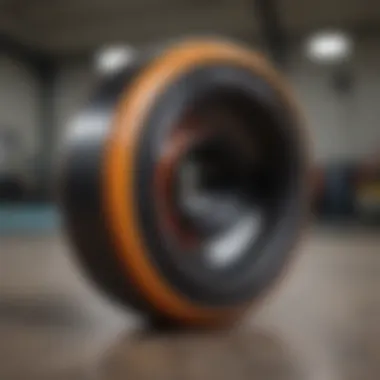Unlocking the Influence of Street Skateboard Wheels on Performance and Durability


Skateboarding News Updates
In the ever-evolving realm of skateboarding news, staying abreast of the latest developments is paramount for enthusiasts. Whether it's a recap of recent skate competitions that have showcased the immense talent of participants or the buzz surrounding cutting-edge product launches in the industry, keen followers of the sport are always eager for updates that shape the skateboarding landscape.
Gear Reviews and Recommendations
When it comes to selecting the ideal gear for optimal performance in skateboarding, the role of street skateboard wheels cannot be understated. Conducting thorough reviews and comparisons of skateboard decks, trucks, and wheels provides valuable insights for skateboarders looking to enhance their riding experience. With a focus on durability and performance, discerning skaters can make informed decisions based on detailed recommendations and expert analysis.
Healthy Lifestyle for Skaters
While the thrill of skateboarding can be exhilarating, ensuring physical well-being is crucial for longevity in the sport. Incorporating injury prevention exercises into a skater's routine helps mitigate the risks associated with high-impact maneuvers. Additionally, focusing on skateboard-specific fitness and strength training not only improves performance but also safeguards against potential injuries. Furthermore, providing nutrition tips tailored to the dietary needs of skaters empowers athletes to fuel their bodies optimally for sustained energy and endurance on the board.
Introduction
In the realm of street skateboarding, the wheels you choose for your board play a critical role in determining your performance and the durability of your equipment. These seemingly simple components are complex pieces of technology that can significantly impact your overall skateboarding experience. By delving deeper into the nuances of street skateboard wheels, we can unravel the intricate relationship between their composition, durometer rating, and size concerning maneuverability.
Understanding Street Skateboard Wheels
Composition of Street Skateboard Wheels
When we look at the composition of street skateboard wheels, we uncover a crucial aspect that directly influences their performance and durability. These wheels are predominantly crafted from polyurethane, a versatile material known for its balance of hardness and resilience. The use of polyurethane offers skateboarders a reliable grip on various surfaces while withstanding the wear and tear of street skating. Its elastomeric properties enhance shock absorption, contributing to a smoother ride and extended longevity of the wheels.
Impact of Wheel Durometer on Performance
The durometer rating of skateboard wheels dictates their hardness, which in turn affects performance on the streets. A higher durometer wheels (around 99A-101A) are ideal for technical tricks as they provide increased speed and slide-ability. On the flip side, lower durometer wheels (around 75A-90A) offer enhanced grip and shock absorption, perfect for cruising or tackling rough terrains. Understanding the impact of durometer on performance is essential for tailoring your setup to match your skating style.


Role of Wheel Size in Maneuverability
The size of your skateboard wheels is a crucial determinant of maneuverability while navigating the urban landscape. Smaller wheels (50-52mm) prioritize agility and quick acceleration, making them perfect for technical tricks and intricate footwork. In contrast, larger wheels (54-60mm) excel in maintaining speed and conquering rugged terrain with ease. Selecting the right wheel size not only influences your riding agility but also defines how you interact with the environment as you skate.
Importance of Choosing the Right Wheels
Durability Vs. Performance Trade-off
When choosing street skateboard wheels, one often encounters the dilemma of balancing durability and performance. Harder wheels may offer improved slide capabilities and speed, but they are more prone to chipping and wearing out quickly. Softer wheels prioritize shock absorption and grip, enhancing comfort but sacrificing some speed. Finding the right balance between durability and performance is key to optimizing your skateboarding setup for longevity and superior performance.
Considerations for Street Skateboarding Style
Each skateboarder has a unique style that defines their approach to street skateboarding. Factors such as trick preference, cruising habits, and terrain exploration heavily influence the type of wheels that suit individual styles. Tailoring your wheel selection to match your street skateboarding style ensures a harmonious connection between your board and your skating techniques, enriching your overall experience on the streets.
Effect of Terrain on Wheel Selection
The diverse terrain of urban landscapes presents skateboarders with varied challenges that demand thoughtful wheel selection. Rough surfaces require wheels with greater shock absorption capabilities to enhance stability and prevent wheel damage. Smoother pavements may benefit from harder wheels to optimize speed and maneuverability. Understanding how different terrains affect your wheel performance enables you to adapt your setup accordingly, ensuring a seamless ride across all landscapes.
Factors Influencing Wheel Performance
In the realm of street skateboarding, the performance of skateboard wheels plays a pivotal role in the overall skateboarding experience. Factors influencing wheel performance encompass various critical elements that directly impact how skateboarders maneuver, execute tricks, and navigate different terrains. Understanding the material composition, durometer rating, and wheel size and shape is fundamental in enhancing performance and durability, allowing skateboarders to optimize their skills and capabilities on the board.
Material Composition
Polyurethane Vs. Urethane Wheels
Exploring the material composition of skateboard wheels unveils the distinction between polyurethane and urethane wheels. Polyurethane wheels, known for their durability and grip, are a popular choice among skateboarders seeking reliability and longevity. On the other hand, urethane wheels prioritize a smoother ride and enhanced control, making them favorable for riders emphasizing precision in their maneuvers. The unique feature of polyurethane wheels lies in their exceptional resilience to wear and tear, ensuring extended usage without compromising performance. Conversely, urethane wheels excel in providing a smooth and consistent ride, contributing to improved stability and maneuverability during street skateboarding sessions.


Impact of Core Design on Performance
The core design of skateboard wheels significantly influences performance on the streets. A well-designed core enhances the overall responsiveness and agility of the wheels, amplifying the rider's ability to execute intricate tricks with precision. The key characteristic of core design lies in its ability to distribute weight evenly across the wheel, allowing for smoother rides and controlled slides. Opting for a core design that matches your skateboarding style can drastically improve your performance, offering optimized stability and maneuverability during challenging skating routines.
Durometer Rating
Understanding Durometer Scales
Delving into durometer scales provides insights into the hardness of skateboard wheels, essential for tailoring performance to your specific needs. Understanding the durometer scale enables skateboarders to select wheels that align with their riding preferences, whether it be cruising on rough terrains or perfecting technical tricks on smooth surfaces. The key characteristic of durometer scales is their ability to indicate the wheel's hardness, influencing factors such as grip and shock absorption during street skateboarding sessions. By comprehending durometer scales, skateboarders can make informed decisions when selecting wheels, enhancing their overall skating experience.
Ideal Durometer for Street Skateboarding
Determining the ideal durometer for street skateboarding involves striking a balance between grip and slide capabilities. The ideal durometer varies based on personal preferences and skateboarding style, with softer wheels offering better grip while harder wheels enable smoother slides. Selecting the ideal durometer is crucial for maximizing performance and durability, ensuring optimal traction and smooth transitions on various street surfaces. By choosing the right durometer for your skateboarding needs, you can elevate your performance and enjoy a customized riding experience tailored to your skill level and riding style.
Wheel Size and Shape
Influence of Diameter on Speed and Control
The diameter of skateboard wheels directly impacts speed and control during street skateboarding sessions. Larger diameter wheels provide increased speed, ideal for cruising and covering more significant distances effortlessly. Conversely, smaller diameter wheels offer enhanced agility and control, perfect for executing precise tricks and maneuvers with finesse. The key characteristic of diameter lies in its effect on speed and responsiveness, enabling skateboarders to tailor their wheels based on their skating preferences and performance goals. By understanding the influence of diameter, riders can optimize their skateboarding experience and achieve their desired balance of speed and control.
Effects of Lip Profile on Slides and Tricks
Exploring the lip profile of skateboard wheels reveals its impact on slides and tricks performed on various surfaces. The lip profile determines how wheels interact with surfaces, affecting slide initiation, control, and stability during technical maneuvers. Different lip profiles offer distinct advantages, with rounded lips promoting smoother slides and squared lips enhancing grip and stability. Understanding the effects of lip profile empowers skateboarders to choose wheels that align with their preferred skating style, enabling them to tackle challenges with confidence and finesse on the streets.
Optimizing Wheel Selection


When it comes to optimizing wheel selection in street skateboarding, every skateboarder knows that the choice of wheels plays a vital role in their performance and durability on the pavement. Not just any wheels will suffice; skaters need to carefully consider various elements like material composition, durometer rating, wheel size, and shape to maximize their experience. Finding the right balance between durability and performance is key to pushing boundaries and honing skills to perfection. By customizing wheel components and following proper maintenance practices, skateboarders can fine-tune their setup for optimal results. Make sure to delve into the nuances of wheel selection to elevate your street skateboarding game.
Customization Options
Mixing and Matching Wheel Components:
Mixing and matching wheel components is a widely adopted practice among seasoned skateboarders looking to elevate their performance. This approach allows skaters to tailor their wheels to specific terrain conditions and personal preferences. By combining different materials, durometers, and sizes, skaters can achieve a customized setup that enhances control, speed, and durability. The flexibility offered by mixing and matching wheel components empowers skateboarders to fine-tune their ride for different skateboarding styles and tricks, making it a popular choice for those seeking versatility.
Personalization for Enhanced Performance:
Personalization for enhanced performance is a game-changer in the world of street skateboarding. Tailoring your wheel setup to match your unique skating style and preferences can make a significant difference in how you tackle obstacles and perform tricks. Whether you prioritize speed, precision, or grip, personalized wheel components can optimize your performance on various surfaces. The ability to customize wheel characteristics such as hardness, size, and shape allows skateboarders to push their limits and unleash their full potential on the streets.
Maintenance Practices
Cleaning and Lubrication Techniques:
Proper cleaning and lubrication techniques are essential for maintaining the longevity and performance of street skateboard wheels. Regularly cleaning your wheels removes dirt, debris, and grime that can affect their performance and lifespan. Lubricating bearings ensures smooth rotation and minimizes friction, enhancing overall ride comfort and speed. By incorporating cleaning and lubrication into your maintenance routine, you can extend the lifespan of your wheels and optimize their performance for longer shredding sessions.
Monitoring Wheel Wear for Replacement:
Monitoring wheel wear for replacement is a proactive approach that prevents performance issues and safety hazards. Over time, skateboard wheels wear down due to constant use and exposure to various surfaces. By regularly inspecting your wheels for signs of wear such as flat spots, cracks, or uneven wear patterns, you can anticipate when replacements are necessary. Proactively replacing worn-out wheels not only improves performance but also reduces the risk of accidents during skate sessions, ensuring a safe and reliable skating experience.
Conclusion
Summary of Key Takeaways
Impact of Wheel Selection on Skateboarding Experience
Exploring the impact of wheel selection on the skateboarding experience reveals a critical aspect of enhancing performance. The choice of wheels influences factors such as speed, control, and maneuverability on various terrains. Skaters need to consider the material composition, durometer rating, and wheel size to optimize their performance. Selecting the appropriate wheels based on individual preferences and skateboarding style can lead to a more enjoyable and successful skating session.
Continual Evolution of Street Skateboard Wheels
The continual evolution of street skateboard wheels showcases an ongoing commitment to improving performance and durability. Manufacturers are constantly innovating to enhance wheel technology, introducing new materials and designs to meet the demands of modern skateboarding. This evolution brings about benefits such as increased durability, better grip, and smoother rides. However, with advancements come considerations such as adaptability to different terrains and the need for maintenance to maximize longevity.







